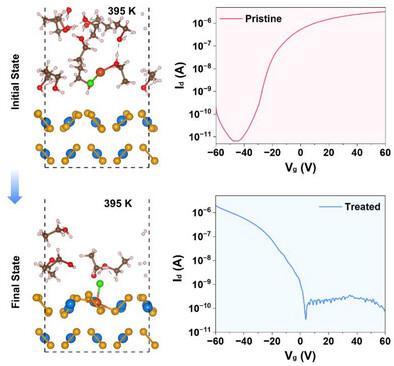用于光电探测器和CMOS逆变器的温度场介导的稳定Lewis酸p型掺杂
IF 12.1
2区 材料科学
Q1 CHEMISTRY, MULTIDISCIPLINARY
引用次数: 0
摘要
由于表面杂质和固有缺陷,n型半导体在二维材料中占主导地位,限制了它们在电子领域的应用。Lewis酸处理能有效地耗尽电子,增加空穴浓度,导致p型掺杂。然而,传统的路易斯酸掺杂方法缺乏稳定性。为了解决这一关键挑战,研究人员开发了一种温度场介导的策略来实现过渡金属二硫族化合物(TMDs)的稳定p型掺杂。在温度场介导的Lewis酸掺杂后,在环境条件下,掺杂的TMDs在31天后几乎保持不变的电性能。采用密度泛函理论(DFT)计算和从头算分子动力学(AIMD)模拟分析了Fe掺杂实现p型掺杂和显著稳定性的机理。该方法适用于一系列过渡金属二硫化物,包括WS2、MoSe2、WSe2和MoTe2。此外,PdSe2 p - n同质结的构建使光电探测器的开关比达到1.4 × 104,响应率为0.33 A/W,比探测率为1.55 × 1011 Jones,同时逆变器的峰值功耗低至60 pW。这项工作通过设计温度场介导的Lewis酸掺杂策略实现了高性能和稳定的p - n同质结应用,从而推动了二维材料改性的发展。本文章由计算机程序翻译,如有差异,请以英文原文为准。

Temperature‐Field‐Mediated Stable Lewis Acid p‐Type Doping of TMDs for Photodetectors and CMOS Inverters
The predominance of n‐type semiconductors in 2D materials, caused by surface impurities and intrinsic defects, limits their electronic applications. Lewis acid treatment can effectively deplete the electrons and increase the hole concentration, resulting in p‐type doping. However, the conventional Lewis acid doping methods lack stability. To address this critical challenge, a temperature‐field‐mediated strategy is developed to achieve stable p‐type doping in transition metal dichalcogenides (TMDs). After temperature‐field‐mediated Lewis acid doping, the doped TMDs retain virtually unchanged electrical properties after 31 days under ambient conditions. Density Functional Theory (DFT) calculations and ab initio molecular dynamics (AIMD) simulations have been employed to analyze the mechanism by which Fe doping achieves p‐type doping and remarkable stability. This method applies to a range of transition metal dichalcogenides, including WS2 , MoSe2 , WSe2 , and MoTe2 . Moreover, the construction of PdSe2 p‐n homojunctions enables photodetectors with an on‐off ratio of 1.4 × 104 , responsivity of 0.33 A/W, and specific detectivity of 1.55 × 1011 Jones, alongside an inverter achieving peak power consumption as low as 60 pW. This work has achieved high‐performance and stable p‐n homojunction applications through the design of a temperature‐field‐mediated Lewis acid doping strategy, thereby advancing the development of 2D material modification.
求助全文
通过发布文献求助,成功后即可免费获取论文全文。
去求助
来源期刊

Small
工程技术-材料科学:综合
CiteScore
17.70
自引率
3.80%
发文量
1830
审稿时长
2.1 months
期刊介绍:
Small serves as an exceptional platform for both experimental and theoretical studies in fundamental and applied interdisciplinary research at the nano- and microscale. The journal offers a compelling mix of peer-reviewed Research Articles, Reviews, Perspectives, and Comments.
With a remarkable 2022 Journal Impact Factor of 13.3 (Journal Citation Reports from Clarivate Analytics, 2023), Small remains among the top multidisciplinary journals, covering a wide range of topics at the interface of materials science, chemistry, physics, engineering, medicine, and biology.
Small's readership includes biochemists, biologists, biomedical scientists, chemists, engineers, information technologists, materials scientists, physicists, and theoreticians alike.
 求助内容:
求助内容: 应助结果提醒方式:
应助结果提醒方式:


